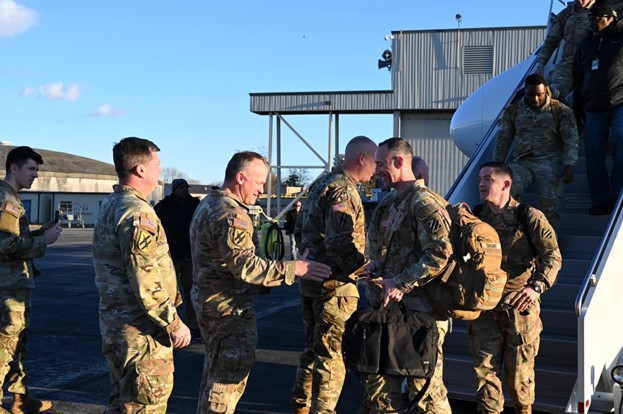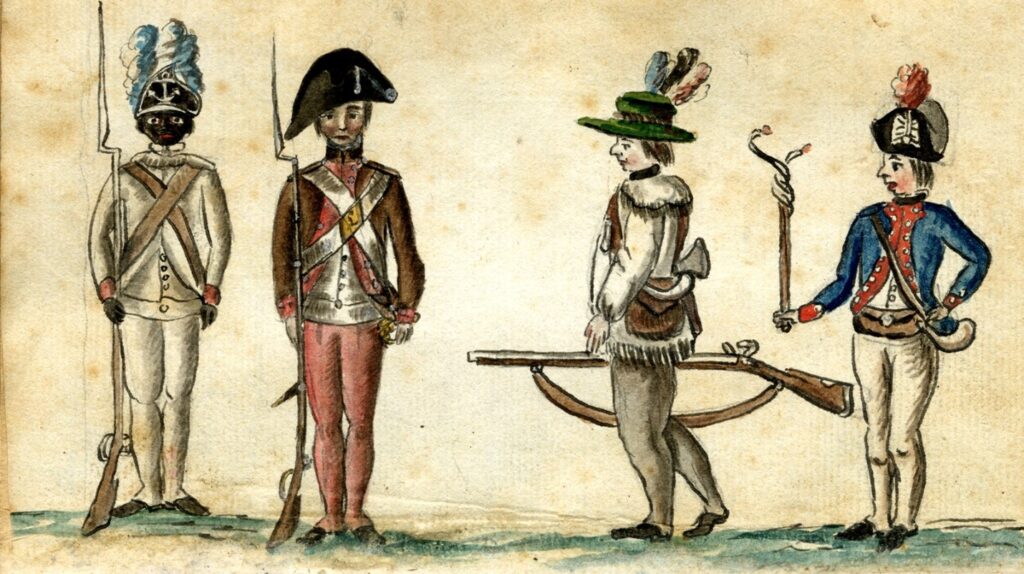By Maj. William Carraway

(Courtesy of Facebook, Photos by Major William Carraway and Major Amanda Russell)
Prelude
On June 9, 1732, the charter for the colony of Georgia was granted by King George II. Among the articles in the charter was the establishment of a militia which would initially fall under the authority of the Governor of South Carolina.1 Upon arriving in Savannah in 1733, Lord James Oglethorpe saw to the regulation of the militia and, in 1742, led them to victory over the Spanish at the Battle of Bloody Marsh.
The earliest elements of the 1-118th were organized on April 18, 1751, in Savannah.2 This initial organization encompassed four militia units, including a troop of mounted rangers which had formed in 1749.3 In January 1776, these units were reorganized and formed part of the 1st Battalion, 1st Brigade, 1st Division of the Georgia Militia and detailed for the protection of Savannah.4
In 1778, with prospects for a swift victory dimming in the northern colonies, the British shifted to a southern strategy. The first objective of the southern strategy was the vital port of Savannah.
Dispatched from New York City, British Lt. Col. Archibald Campbell arrived in the vicinity of Savannah in December 1778 with a force of approximately 3,000 Soldiers. As he waited for additional forces marching north from Florida, Campbell surveyed the American defenses.
Defending Savannah was a mixed force of approximately 600 continental and militia troops under the command of Maj. Gen. Robert Howe. Howe’s defensive position was compromised by the general’s unfamiliarity with the terrain, and the paths of approach enemy forces could negotiate through swamps and rural roads. American troops were arrayed in a line of defense protecting Savannah from enemy advances from land. The militia troops were posted on the right section of Howe’s defensive line north and east of Savannah. Colonel George Walton, commanding the 1st Regiment, Georgia Militia, alerted Howe to the threat of unguarded roads in the vicinity of his troops, but his warning went unheeded.5

(Courtesy of “A brief history of the North Carolina troops on the Continental establishment” by Charles Lukens Davis & Henry Hobart Bellas)
Among Walton’s troops facing these roads were those of the 1st Battalion, Georgia Militia, whose ranks had swelled with the addition of an artillery company that had joined the battalion in April. Commanded by Maj. Joseph Woodruff, the battery had at its disposal one brass field piece.6
The Capture of Savannah
Taking stock of Savannah’s defenses, Campbell decided not to wait for reinforcements. With his much larger force, Campbell resolved to take the city by striking the American flank using the very roads Walton had reported to Howe.
Advancing from his landing site on the Savannah River, Campbell positioned the bulk of his forces across the main road northwest of Savannah between the plantations of Governor James Wright and Brig. Gen. Josiah Tattnall. With Howe’s forces blocking his advance, Campbell dispatched the 1st Battalion, 71st Regiment along with the light infantry companies at his disposal on a circuitous march east along a narrow road through swampy terrain. With his main force demonstrating on Howe’s left, and their movement screened by trees, the flanking force moved into position with the artillery behind a slight rise in terrain to the left of the road, concealing them from the militia until the infantry attack. After deploying into a line of battle, the British infantry advanced striking the position of the 1st Battalion, Georgia Militia. The speed and shock of the attack routed the Americans whose entire line collapsed under the coordinated advance on both flanks.7
While Howe’s force suffered a crushing defeat at Savannah the General singled out the performance of the 1st Battalion as exemplary:
“The militia under (COL Walton’s) command who formed part of our right behaved exceedingly well, particularly the company of artillery under Major Woodruff, who notwithstanding a hot fire, maintained against great odds for some time a field piece which seemed to be well directed and for which the Major deserves great praise,” Howe wrote two days after the battle.8
Aftermath
With the capture of Savannah complete, Campbell returned to Augusta where he developed plans to attack militia forces assembled near the confluence of the Savannah River and Brier Creek. Before he could bring those plans to fruiting, Campbell was recalled to England and relinquished command to Lt. Col. Mark Prevost. On March 3, 1779, Prevost executed Campbell’s attack plan delivering a crushing defeat to Patriot forces at the Battle of Brier Creek.

(Courtesy of Facebook, Photos by Major William Carraway and Major Amanda Russell)
The 1st Battalion Today
The 1st Battalion, 1st Regiment, Georgia Militia has remained in continuous service to the present day, serving in the War of 1812, the Civil War, and the Spanish-American War. During the twentieth century, the unit deployed to the Mexican Border in 1916 and received its current designation as the 1st Battalion, 118th Field Artillery in 1917 before mobilizing to France. Units of the 118th served in the European and Pacific theaters of World War II and have completed four overseas combat tours in Iraq and Afghanistan since September 11, 2001.
Footnotes:
1 Gordon Burns Smith, History of the Georgia Militia: 1783-1861, Volume 4. (Milledgeville, GA: Boyd Publishing, 20004), 43.
2 Gordon Burns Smith, History of the Georgia Militia: 1783-1861, Volume 4. (Milledgeville, GA: Boyd Publishing, 20004), 44.
3 Gordon Burns Smith, History of the Georgia Militia: 1783-1861, Volume 4. (Milledgeville, GA: Boyd Publishing, 20004), 65-70.
4 U.S. Army Center of Military History. Lineage and Honors, 118th Field Artillery Regiment. Washington, DC: U.S. Army Center of Military History, 1996.
5 Ronald G. Killian and Charles T. Waller, Georgia and the Revolution. (Atlanta: Cherokee Publishing, 1975), .54.
6 Gordon Burns Smith, The Chatham Artillery: 1786-2011. (Savannah, GA: Gordon B. Smith, 2011), 7.
7 Ronald G. Killian and Charles T. Waller, Georgia and the Revolution. (Atlanta: Cherokee Publishing, 1975), 183-186.
8 General Robert Howe to General Benjamin Lincoln, Camp on the road from Zubley’s Ferry, December 30, 1778. National Archives, Microfilm Series 247 177 158. (Washington, DC: National Archives), 189.
Bibliography:
General Robert Howe to General Benjamin Lincoln, Camp on the road from Zubley’s Ferry, December 30, 1778. National Archives, Microfilm Series 247 177 158, Washington DC: National Archives.
History in Action: 118th Field Artillery, 30th Infantry Division 1942-1945, 2nd Edition. Washington, DC: Florida “Gator” Chapter, 1988.
Killian, Ronald G. and Waller, Charles T. Georgia and the Revolution. Atlanta: Cherokee Publishing, 1975.
Phelipeau, René, Active. Taking of Savannah in De. [1778] Map. https://www.loc.gov/item/gm71000863/.
Smith, Gordon Burns. History of the Georgia Militia: 1783-1861. Milledgeville, GA: Boyd Publishing, 2000.
Smith, Gordon Burns, The Chatham Artillery: 1786-2011. Savannah, GA: Gordon B. Smith, 2011. U.S. Army Center of Military History. Lineage and Honors, 118th Field Artillery Regiment. Washington DC: U.S. Army Center of Military History, 1996





